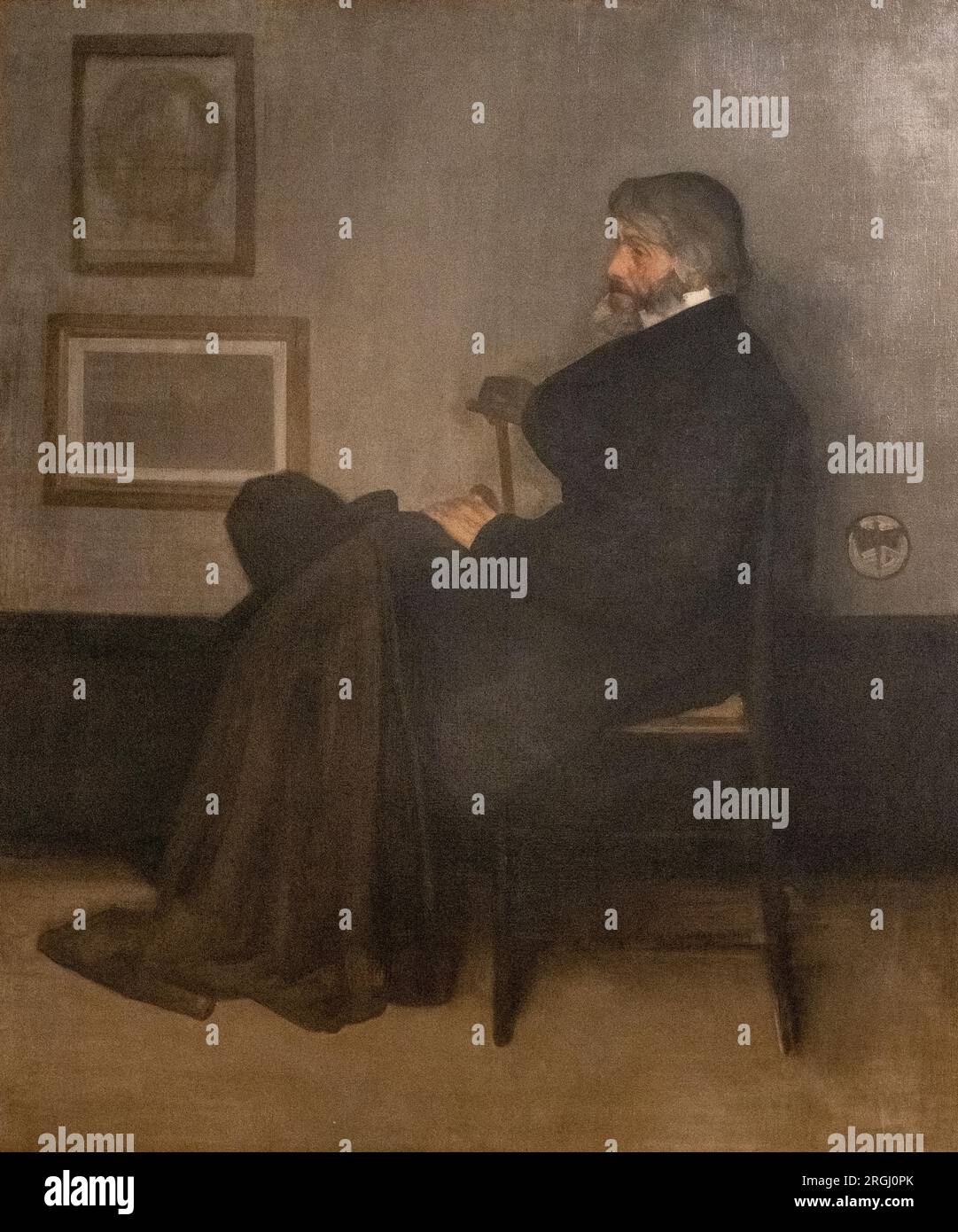Decoding Whistler’s Mother: The Story Behind Arrangement in Grey and Black No. 1
James Abbott McNeill Whistler, an American expatriate artist working in 19th-century London, created one of the most recognizable images in art history: Arrangement in Grey and Black No. 1, more commonly known as Whistler’s Mother. Painted in 1871, this iconic portrait exemplifies the Aesthetic movement, a philosophy championing “art for art’s sake,” prioritizing beauty and visual harmony over narrative or moral content. This exploration delves into the painting’s creation, reception, enduring legacy, and the ongoing research that continues to shape our understanding of this masterpiece. Curious about other influential artists? Explore the dynamic works of Jackson Pollock Lavender Mist or the monumental sculptures of Mark Di Suvero.
Whistler’s Vision: A Symphony in Grey and Black
The title itself, Arrangement in Grey and Black No. 1, offers crucial insight into Whistler’s artistic intentions. Rather than a traditional portrait, Whistler presents a carefully composed arrangement of forms and colors, much like a musical piece. His restricted palette, dominated by subtle gradations of grey and black with delicate touches of white, creates a quiet, contemplative atmosphere, drawing the viewer’s attention to the interplay of light and shadow, texture, and the overall harmony of the composition. This minimalist approach, stripping away extraneous details, allows the viewer to focus on the essential: the figure’s dignified posture, the subtle expression on her face, and the quiet power of the arrangement itself.
Anna McNeill Whistler, the artist’s mother, sits in profile against a plain, neutral background. Her upright pose, hands clasped calmly in her lap, suggests both strength and introspection. The vertical and horizontal lines of her figure, chair, and curtain create a sense of stability and stillness. While the subject is undoubtedly Whistler’s mother, some art historians have suggested the possibility of a professional model posing as Anna, adding another layer of intrigue to the painting’s history.
From Uncertainty to Icon: An Accidental Masterpiece
Initially met with uncertainty by critics accustomed to narrative-driven art, Arrangement in Grey and Black No. 1 gradually gained recognition for its unconventional beauty and surprising emotional depth. This seemingly simple composition resonates with viewers on a profound level, perhaps due to its universality. Many interpret the painting as a representation of motherhood, aging gracefully, and the quiet dignity of the human experience. Others are drawn to its formal qualities, appreciating the balanced composition and subtle harmonies. It’s fascinating how a painting initially met with confusion eventually became an iconic image, permeating popular culture and inspiring artists across diverse mediums.
Whistler’s Mother’s Enduring Influence: Beyond the Canvas
Arrangement in Grey and Black No. 1 has transcended the realm of fine art, becoming embedded in our collective cultural memory. Its influence extends to music, inspiring Claude Debussy’s Nocturnes, and it has been parodied and referenced in countless films, television shows, and even cartoons. From The Rocky Horror Picture Show to Bean and I Am Legend, the painting’s enduring presence in popular culture speaks to its ability to connect with audiences across generations. Further, the painting has traveled extensively, exhibited internationally, including notable showings in the United States, such as its appearance at the Century of Progress world’s fair in Chicago (1933-1934).
The Power of Simplicity: Why “Arrangement in Grey and Black”?
The formal title reinforces Whistler’s artistic philosophy. By choosing “Arrangement in Grey and Black No. 1” over a more conventional title like “Portrait of Mother,” Whistler emphasizes his focus on formal elements rather than the subject’s identity. This aligns with the Aesthetic movement’s emphasis on “art for art’s sake,” prioritizing beauty and the arrangement of color and form over narrative. This concept may have been influenced by musical compositions, often titled “Arrangement in…” or “Symphony in…,” further suggesting Whistler’s intention to elevate painting to the level of music.
The limited color palette enhances this focus, stripping away distractions and allowing viewers to appreciate the subtle nuances of the painting. This minimalist approach directs attention to the interplay of light and shadow, tone, and texture, creating a sense of unity and quiet contemplation. The title itself challenges traditional portraiture conventions, prompting a deeper consideration of what constitutes a portrait and how artists can subvert expectations.
The Mystery of the Wall: An Intentional Void
A common misconception surrounds the wall behind Whistler’s mother. It’s often assumed that a painting hangs there, but the wall is intentionally bare. This minimalist approach, a hallmark of Whistler’s style, enhances the painting’s overall serenity and directs attention to the central figure and the delicate balance of light and shadow. The absence of any other visual elements reinforces the “art for art’s sake” philosophy, emphasizing the beauty of the arrangement itself rather than any external narrative or symbolism.
While some may speculate about potential symbolic meanings behind the empty wall, Whistler’s primary intention likely centered on creating a powerful visual experience. This deliberate choice reinforces his focus on form, composition, and the interplay of light and shadow.
Unveiling Whistler’s Legacy: Ongoing Research and Future Interpretations
While much has been written about Arrangement in Grey and Black No. 1, art historians continue to research Whistler’s life, influences, and the circumstances surrounding the painting’s creation. New information may yet emerge, reshaping our understanding of this iconic work. Ongoing research explores Whistler’s aesthetic philosophy, the psychological nuances of the mother-son relationship depicted, and comparisons with traditional portraiture, enriching our appreciation of Whistler’s innovative approach. Even the original frame, designed by Whistler himself, warrants further investigation, as it was considered an integral part of the artwork.
This ongoing dialogue surrounding Whistler’s Mother testifies to its enduring power and its capacity to inspire continued interpretation and contemplation. The painting remains a testament to the power of simplicity, subtlety, and a profound understanding of visual harmony, reminding us that sometimes, the quietest statements speak the loudest.
- Unlock Elemental 2 Secrets: Actionable Insights Now - April 2, 2025
- Lot’s Wife’s Name: Unveiling the Mystery of Sodom’s Fall - April 2, 2025
- Photocell Sensors: A Complete Guide for Selection and Implementation - April 2, 2025
















